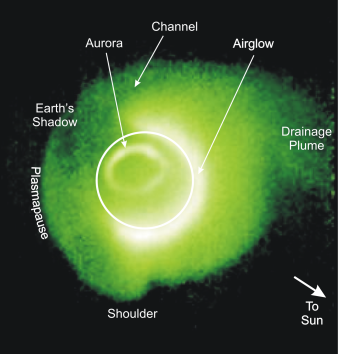Useful Links
EUV Instrument Homepage
at University of Arizona
IMAGE Science Center at NASA GSFC
The IMAGE Mission
The Imager for Magnetopause-to-Aurora Global Explorer (IMAGE) was the first satellite mission dedicated to imaging<
Useful Links
EUV Instrument Homepage
at University of Arizona
IMAGE Science Center at NASA GSFC
The IMAGE Mission
The Imager for Magnetopause-to-Aurora Global Explorer (IMAGE) was the first satellite mission dedicated to imaging the Earth’s magnetosphere, the region of space dictated by the Earth’s magnetic field which contains a complex plasma environment sourced by both interaction with the solar wind as well as the Earth’s upper atmosphere. This region of space, which is invisible to typical optical observing methods, had previously only been studied by use of localized measurements with charged particle detectors, magnetometers, and electric field instruments. Instead of relying on such single point measurements, IMAGE used a host of novel imaging techniques to “see the invisible” and to produce the first global images of many of certain plasma populations within the Earth’s magnetosphere. Employing these imaging techniques has allowed for observations of the Earth’s plasma environment never before possible, providing observation of global-scale dynamics as a response to varying conditions from the Sun and Earth.

|
The EUV Instrument
The IMAGE extreme ultraviolet (EUV) instrument images the He+ distribution in the Earth’s plasmasphere by detecting resonantly scattered solar 30.4-nm radiation. Since the plasmaspheric He+ emission is optically thin, the integrated
column density of He+ along the line of sight through the plasmasphere is directly
proportional to the intensity of the emission. Because of the IMAGE spacecraft’s high apogee altitude (about 7 Earth radii), as shown in Figure 1, and the EUV imager’s wide field of view, images generated from data acquired near apogee show the structure of the entire plasmasphere. An example showing several features captured by the IMAGE EUV image are shown in Figure 2.
Plasmaspheric Dynamics
The structure and dynamics of the plasmasphere are highly sensitive to the geomagnetic disturbance activity that occurs regularly within the Earth’s magnetosphere. The cycles of erosion and refilling of the plasma population in the plasmasphere have been studied extensively in the past but from the relatively limited perspective of individual ground stations and satellite crossings of the plasmapause and plasmasphere. Data available from the Extreme Ultraviolet Imager (EUV) on the IMAGE satellite allow us, for the first time, to study the plasmasphere system from a global perspective.
The plasmasphere is a central element in many of the complex interactions within
the magnetosphere, and thus knowledge of its dynamics on a global scale is
important for a variety of reasons. First of all, the size and shape of the plasmasphere
give an indication, although in a complex integral sense, of the recent time history of
magnetospheric convection, an important global process within the magnetosphere (see Spasojevic et al. (2003)).
Convection in the inner magnetosphere is complex and not accurately described in the
simple, but widely used, global models. Secondly,
the plasmasphere contains a large of amount of mass, and during geomagnetic disturbances a significant amount of that mass is removed (see Spasojevic and Sandel (2010).
This large-scale mass redistribution can significantly effect other coupling processes, including dayside reconnection.
 |
Finally, the cold plasma density is a fundamental parameter in
the generation and propagation of plasma waves and the interaction of these waves
with energetic particles. Wave-particle interactions play an important role in the loss
(through precipitation into the upper atmosphere) of energetic particles (Spasojevic et al., 2004; Spasojevic and Fuselier, 2009; Spasojevic et al., 2005) and may also
contribute to the storm-time acceleration of radiation belt electrons (Spasojevic and Inan, 2005; Horne et al., 2005).
 |
Acknowledgements
This research is funded by the National Aeronautics and Space Administration (NASA), the National Science Foundation (NSF) under the Geospace Environment Modeling (GEM) inititative, and the NASA Living With a Star (LWS) Heliophysics Postdoctoral Fellowship Program, administered by the UCAR Visiting Scientist Programs (VSP).
Bibliography
Horne, R. B., et al., Wave acceleration of electrons in the Van Allen
radiation belts, , 437, 227-230, 2005.
Spasojevic, M., and S. A. Fuselier, Temporal evolution of proton
precipitation associated with the plasmaspheric plume, J. Geophys. Res.
(Space Phys.), 114, 12,201, 2009.
Spasojevic, M., and U. S. Inan, Ground based vlf observations near l = 2.5
during the halloween 2003 storm, Geophysical Research Letters, 32, 21,103, 2005.
Spasojevic, M., and B. R. Sandel, Global estimates of plasmaspheric losses
during moderate disturbance intervals, Annales Geophysicae, 28, 27-36, 2010.
Spasojevic, M., J. Goldstein, D. L. Carpenter, U. S. Inan, B. R.
Sandel, M. B. Moldwin, and B. W. Reinisch, Global response of the
plasmasphere to a geomagnetic disturbance, J. Geophys. Res. (Space
Phys.), 108, 1340, 2003.
Spasojevic, M., H. U. Frey, M. F. Thomsen, S. A. Fuselier, S. P.
Gary, B. R. Sandel, and U. S. Inan, The link between a detached
subauroral proton arc and a plasmaspheric plume, Geophys. Res.
Lett., 31, 4803, 2004.
Spasojevic, M., M. F. Thomsen, P. J. Chi, and B. R. Sandel, Afternoon
Subauroral Proton Precipitation Resulting from Ring Current-Plasmasphere
Interaction, Washington DC American Geophysical Union Geophysical
Monograph Series, 159, 85, 2005.

